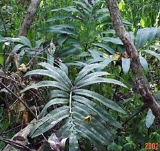
Stangeriaceae
Encyclopedia
Stangeriaceae is the smallest family of cycad
s, both in number of living and fossil
species. The family contains only two living genera, Stangeria
and Bowenia
, though the latter genus has been recommended for placement in a separate family by itself.
The family is recognized by having vascularized stipules, and by lacking cataphylls, or producing them irregularly. These unusual characters led to the original description of Stangeria
as a fern
, and it was only when seed
s were later produced on the plant that its true affinities were realized.
Though today the family occurs only in South Africa
and Queensland
, Australia
, fossils are known from Jurassic
sediments in Argentina
and the British Isles
. Recent cladistic studies suggest that the fossil taxon Mesodescolea may also have affinities with the Stangeriaceae. This highly lobed fossil leaf from the Lower Cretaceous
has only been found in Argentina
.
Cycad
Cycads are seed plants typically characterized by a stout and woody trunk with a crown of large, hard and stiff, evergreen leaves. They usually have pinnate leaves. The individual plants are either all male or all female . Cycads vary in size from having a trunk that is only a few centimeters...
s, both in number of living and fossil
Fossil
Fossils are the preserved remains or traces of animals , plants, and other organisms from the remote past...
species. The family contains only two living genera, Stangeria
Stangeria
Stangeria eriopus is a cycad endemic to southern Africa It is the sole species in the genus Stangeria, most closely related to the Australian genus Bowenia, with which it forms the family Stangeriaceae....
and Bowenia
Bowenia
The genus Bowenia, includes two living and two fossil species of cycads in the family Stangeriaceae, sometimes placed on their own family Boweniaceae. They are entirely restricted to Australia...
, though the latter genus has been recommended for placement in a separate family by itself.
The family is recognized by having vascularized stipules, and by lacking cataphylls, or producing them irregularly. These unusual characters led to the original description of Stangeria
Stangeria
Stangeria eriopus is a cycad endemic to southern Africa It is the sole species in the genus Stangeria, most closely related to the Australian genus Bowenia, with which it forms the family Stangeriaceae....
as a fern
Fern
A fern is any one of a group of about 12,000 species of plants belonging to the botanical group known as Pteridophyta. Unlike mosses, they have xylem and phloem . They have stems, leaves, and roots like other vascular plants...
, and it was only when seed
Seed
A seed is a small embryonic plant enclosed in a covering called the seed coat, usually with some stored food. It is the product of the ripened ovule of gymnosperm and angiosperm plants which occurs after fertilization and some growth within the mother plant...
s were later produced on the plant that its true affinities were realized.
Though today the family occurs only in South Africa
South Africa
The Republic of South Africa is a country in southern Africa. Located at the southern tip of Africa, it is divided into nine provinces, with of coastline on the Atlantic and Indian oceans...
and Queensland
Queensland
Queensland is a state of Australia, occupying the north-eastern section of the mainland continent. It is bordered by the Northern Territory, South Australia and New South Wales to the west, south-west and south respectively. To the east, Queensland is bordered by the Coral Sea and Pacific Ocean...
, Australia
Australia
Australia , officially the Commonwealth of Australia, is a country in the Southern Hemisphere comprising the mainland of the Australian continent, the island of Tasmania, and numerous smaller islands in the Indian and Pacific Oceans. It is the world's sixth-largest country by total area...
, fossils are known from Jurassic
Jurassic
The Jurassic is a geologic period and system that extends from about Mya to Mya, that is, from the end of the Triassic to the beginning of the Cretaceous. The Jurassic constitutes the middle period of the Mesozoic era, also known as the age of reptiles. The start of the period is marked by...
sediments in Argentina
Argentina
Argentina , officially the Argentine Republic , is the second largest country in South America by land area, after Brazil. It is constituted as a federation of 23 provinces and an autonomous city, Buenos Aires...
and the British Isles
British Isles
The British Isles are a group of islands off the northwest coast of continental Europe that include the islands of Great Britain and Ireland and over six thousand smaller isles. There are two sovereign states located on the islands: the United Kingdom of Great Britain and Northern Ireland and...
. Recent cladistic studies suggest that the fossil taxon Mesodescolea may also have affinities with the Stangeriaceae. This highly lobed fossil leaf from the Lower Cretaceous
Cretaceous
The Cretaceous , derived from the Latin "creta" , usually abbreviated K for its German translation Kreide , is a geologic period and system from circa to million years ago. In the geologic timescale, the Cretaceous follows the Jurassic period and is followed by the Paleogene period of the...
has only been found in Argentina
Argentina
Argentina , officially the Argentine Republic , is the second largest country in South America by land area, after Brazil. It is constituted as a federation of 23 provinces and an autonomous city, Buenos Aires...
.

